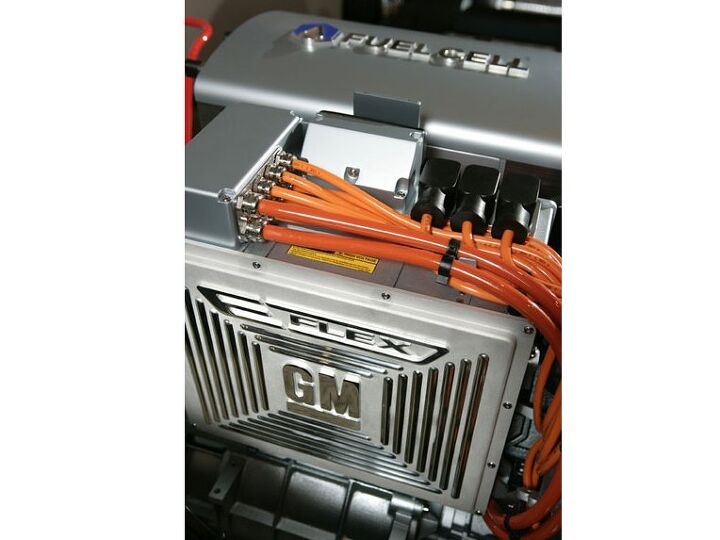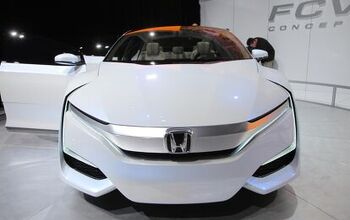Department Of Energy: Hydrogen Still The Future
Same as it ever was. Green Car Congress covers a DOE report (pdf) to the U.S. Congress on its $1.2b Hydrogen fuel cell development caucus, and the conclusion is clear: keep waiting. The DOE had harbored a shockingly naive hope that OEMs would be able to field 100k fuel cell vehicles by 2010, but the new report seems pretty clear on the chances of that happening. According to the report, “a 2008 independent study estimated that the high-volume manufacturing cost of automotive fuel cell systems (using current technology and assuming 500,000 units per year) would be $73/kW, which equates to almost $6000 for an 80-kW system. This current technology would be more than twice as expensive as internal combustion engine systems. And, based on the highest demonstrated durability to date, fuel cell systems would have a lifespan of approximately 1900 hours, which equates to about 57,000 miles and is still substantially lower than today’s estimated vehicular lifespan of 150,000 miles.” Sound familiar?
But, don’t worry. That $1.2b went to good use, “improving understanding of size range and spatial distribution of nano-scale water channels in Nafion membranes; . . . Developing and demonstrating a novel cryo-compressed tank concept” for which “system cost remains an issue”; and countless other “breakthroughs” which somehow don’t make hydrogen any less of a pipedream than it was two decades ago. The best part? “While fuel cell technology development is currently on track to meet the Program’s 2015 technology-readiness targets, it is too early to determine whether industry can achieve the 2020 vehicle deployment goal of 2.5 million hydrogen-fueled vehicles identified in [Energy Policy Act] section 811(a). However, analyses conducted by Oak Ridge National Laboratory indicate that such a deployment scenario would not be achieved without substantial supportive policies and incentives.” Fantastic. But hey, the DOE wants your feedback on their hydrogen dreams. Check out their request for information (RFI) here.
More by Edward Niedermeyer
Latest Car Reviews
Read moreLatest Product Reviews
Read moreRecent Comments
- Joe65688619 Under Ghosn they went through the same short-term bottom-line thinking that GM did in the 80s/90s, and they have not recovered say, to their heyday in the 50s and 60s in terms of market share and innovation. Poor design decisions (a CVT in their front-wheel drive "4-Door Sports Car", model overlap in a poorly performing segment (they never needed the Altima AND the Maxima...what they needed was one vehicle with different drivetrain, including hybrid, to compete with the Accord/Camry, and decontenting their vehicles: My 2012 QX56 (I know, not a Nissan, but the same holds for the Armada) had power rear windows in the cargo area that could vent, a glass hatch on the back door that could be opened separate from the whole liftgate (in such a tall vehicle, kinda essential if you have it in a garage and want to load the trunk without having to open the garage door to make room for the lift gate), a nice driver's side folding armrest, and a few other quality-of-life details absent from my 2018 QX80. In a competitive market this attention to detai is can be the differentiator that sell cars. Now they are caught in the middle of the market, competing more with Hyundai and Kia and selling discounted vehicles near the same price points, but losing money on them. They invested also invested a lot in niche platforms. The Leaf was one of the first full EVs, but never really evolved. They misjudged the market - luxury EVs are selling, small budget models not so much. Variable compression engines offering little in terms of real-world power or tech, let a lot of complexity that is leading to higher failure rates. Aside from the Z and GT-R (low volume models), not much forced induction (whether your a fan or not, look at what Honda did with the CR-V and Acura RDX - same chassis, slap a turbo on it, make it nicer inside, and now you can sell it as a semi-premium brand with higher markup). That said, I do believe they retain the technical and engineering capability to do far better. About time management realized they need to make smarter investments and understand their markets better.
- Kwik_Shift_Pro4X Off-road fluff on vehicles that should not be off road needs to die.
- Kwik_Shift_Pro4X Saw this posted on social media; “Just bought a 2023 Tundra with the 14" screen. Let my son borrow it for the afternoon, he connected his phone to listen to his iTunes.The next day my insurance company raised my rates and added my son to my policy. The email said that a private company showed that my son drove the vehicle. He already had his own vehicle that he was insuring.My insurance company demanded he give all his insurance info and some private info for proof. He declined for privacy reasons and my insurance cancelled my policy.These new vehicles with their tech are on condition that we give up our privacy to enter their world. It's not worth it people.”
- TheEndlessEnigma Poor planning here, dropping a Vinfast dealer in Pensacola FL is just not going to work. I love Pensacola and that part of the Gulf Coast, but that area is by no means an EV adoption demographic.
- Keith Most of the stanced VAGS with roof racks are nuisance drivers in my area. Very likely this one's been driven hard. And that silly roof rack is extra $'s, likely at full retail lol. Reminds me of the guys back in the late 20th century would put in their ads that the installed aftermarket stereo would be a negotiated extra. Were they going to go find and reinstall that old Delco if you didn't want the Kraco/Jenson set up they hacked in?


































Comments
Join the conversation
Hydrogen, even liquid hydrogen, is so light that any given volume of it carries very little energy. One liter of liquid hydrogen contains 71 grams of hydrogen. One liter of gasoline contains 118 grams of hydrogen, and one liter of diesel, 130 grams. Of course liquid hydrogen costs lots of energy to make, is difficult to store (it will leak out of any container in a matter of days), and is 423 degrees F below zero, so be very careful when handling it. Compressed hydrogen is less dense than liquid, and kaboom.
Seems as if the DOE wants to curtail their spending on the hydrogen economy. Even Ballard Power in Canada saw fit to exit the fuelcells-for-cars business some time ago. The announcement came as they spun off their test cell business. Confidence couldn't have been high at the time as it needed the key researchers to form the management team of this new entity. Later on this team secured all the related equipment in a buyout package. At least that was my understanding. Though hydrogen may be the the first to go here, I can see when American Leyland eventually goes under that the DOE will have even more reason to terminate other related powertrain programs it has scattered among the various National Labs. It almost seems that research in North America is wholly in the public sector, with the costs socialised wherever possible and when applicable the profits privatised. It makes me feel that the government should form an engineering corp just like we have the police, teachers, mail delivery and other public services. That it is a given that you become a government worker as an entitlement when you leave college/university and only in rare cases do you move out into the employ of capitalised companies. T2